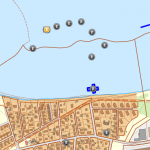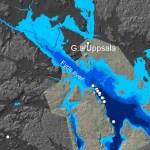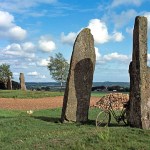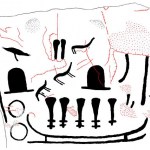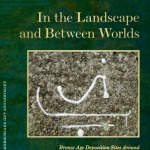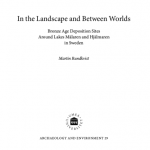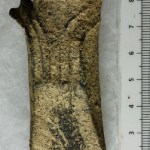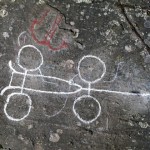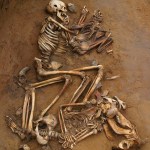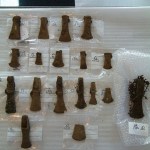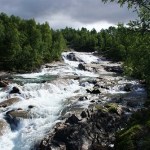bronze age
Archaeological sites in Lake Vättern off Huskvarna
The latest inland ice was 3 km thick and its weight left a big dent in Scandinavia. Since deglaciation (which is, on the geological time scale, a current event) the dent has been straightening out. This causes land uplift. But just outside the edge of the dent, it causes the land to sink. Southernmost Scandinavia is losing land to the sea, not gaining it.
The fulcrum of this see-saw crosses Lake Vättern right at its southernmost point. The lake is receding at one end and encroaching at the other. This is why there is an Early Bronze…
I've linked before to Christina Fredengren's ground-breaking paper in Fornvännen 2015:3 about human and animal remains found in wet contexts in Uppland province (the area around Uppsala). The study's empirical base is solid and eye-opening. I don't find find the theoretical superstructure that the author briefly sketches onto it (the titular ”water politics”) convincing. But that's not my main complaint about this otherwise excellent piece of research.
Look at the map above, covering a small part of the study area. Bear in mind that due to the relieved pressure of the inland ice,…
Sweden's bedrock has been entirely abraded by the inland ice. It sanded down the country like a big wood planer, leaving smooth lovely outcrops known as hällar all over the place. This is the main natural prerequisite of Sweden's rich rock art tradition. Most of it dates from the Bronze Age, 1700–500 BC.
Denmark hardly has any visible bedrock, so they don't have much rock art over there, and what they do have tends to be on boulders. It is thus hardly surprising that when you do find figurative art on boulders in Sweden, it tends to be in the provinces closest to Denmark.
Near Asige church in…
The new version of a slab from the Kivik cairn.
Fornvännen 2015:1 is now on-line on Open Access.
Sven Sandström on fake Paleolithic art in France.
Andreas Toreld and Tommy Andersson on sensational new discoveries on the carved slabs of the Kivik burial cairn. They've been endlessly discussed for over 200 years, and now the whole game just changes.
Birgit Maixner on a new Late 1st Millennium elite site at Missingen/Åkeberg in Norway.
Inger Jans et al. on the last users of runes in the unbroken tradition from the Iron Age on – around 1910!
Anders Söderberg on one of these lovely little…
Dear Reader, it is with great pleasure that I announce the PDF publication of my fifth monograph,* In the Landscape and Between Worlds. The paper version will appear in April or May. Here's the back-cover blurb.
Bronze Age settlements and burials in the Swedish provinces around Lakes Mälaren and Hjälmaren yield few bronze objects and fewer of the era's fine stone battle axes. Instead, these things were found by people working on wetland reclamation and stream dredging for about a century up to the Second World War. Then the finds stopped because of changed agricultural practices.
The objects…
I've finalised the cover of my upcoming book with designer Bitte Granlund!
Cover image: detail of a rock-art panel at Hemsta in Boglösa, Uppland. An axe with its characteristic s-shaped haft, an incomplete ship and two cupmarks. According to Johan Ling, the panel’s ship types and the level above the sea indicate a date in Per. II, about 1400 cal BC. The closest known Early Bronze Age deposition site is Hjältängarna at Grop-Norrby in Vårfrukyrka, about 14 km to the NNW. An axe was deposited there a century or two after the Hemsta carvings were made. Photograph by Sven-Gunnar Broström.
Bitte Granlund of Happy Book has sent me PDF proofs for my forthcoming Bronze Age book, looking bee-you-tiful!
If you'd like to help me proofread it, please email me. Everyone who finds ten errors gets a dedicated copy sent by mail.
To my delight, the response to my plea has been strong. At the moment I believe I have enough volunteer proof readers.
Since late ’09 my main research project has concerned the Bronze Age in the four Swedish provinces surrounding Lakes Mälaren and Hjälmaren. I've looked at the landscape situation of the era's deposition sites, which is pretty much where you find bronze objects. Yesterday I finished the first draft of the book (except the descriptive gazetteer, into which I still need to stick a few bits). And so here it is (300 kB PDF file)! The title is:
In the Landscape and Between Worlds. Bronze Age Deposition Sites Around Lakes Mälaren and Hjälmaren in Sweden.
I would be very grateful for comments,…
I found an excellent argument in a recent paper by Svend Hansen,* clinching something in a particularly satisfying way.
Certain Bronze Age hoards in Northern Europe contain a lot of fragmented objects. But the pieces rarely add up to complete artefacts. In 2001 Stuart Needham argued that this may be due to a custom similar to that known e.g. from ancient Greece, where an animal was sacrificed and only certain parts that make poor eating were burnt as offerings to a god (a sleight of hand taught to humanity by Prometheus the trickster). Perhaps most scrap metal hoards from Northern Europe…
I've started to assemble pictures and maps for my Bronze Age book. Almost all known objects from deposition sites in the Lakes Mälaren and Hjälmaren areas have already been illustrated elsewhere. But here's an exception: a socketed bronze axe found before 1963 in a bog at Eklunda in Bred parish, near Enköping, Uppland province. It's 3,000 years old, dating from Period IV, 1100-950/20 cal BC.
Axes like this were fitted onto hafts shaped like a V with one very short arm, and held in place by a string or strap through the little lug near the base – which is damaged in this case. The verdigris…
I'm doing the final library work for my Bronze Age book. When working on a big research project, I always find it a little difficult to calibrate the most economical way to schedule my reading. Of course, I have to know early on what's in the literature on the subject I'm working with. But I also like to start writing early. And I'd rather not put too much time into re-reading stuff after I've figured out how it's relevant to my theme. I read some of it before I start writing, most of it while I'm writing, often at the computer, and then I inevitably save some of it until I'm almost done…
On 10 June I blogged about some grisly finds from Cliffs End in Kent which to my mind indicate eight centuries of human sacrifice during the Late Bronze and Iron Ages. I invited colleagues at Wessex Archaeology who did the dig to comment, and Chief Osteoarcheologist Jacqueline McKinley kindly sent me some detailed views.
The first thing to note is that though the full monograph hasn't appeared yet and my blog entry was based on a pop-sci feature in British Archaeology, a scholarly paper on the site has in fact been published:
McKinley, Schuster, & Millard 2013. Dead-sea connections: a…
Bronze Age rock art along Sweden's south-east coast is rich but not as varied as that of the famous west-coast region. One motif that we have been missing is the four-wheel wagon. It isn't common anywhere except on one site, Frännarp in inland Scania (below right), but we have had none whatsoever where I am.
Wagons at Frännarp in Scania
The other day we got our first wagon: at the rich classical site of Himmelstalund on the outskirts of Norrköping in Östergötland province. According to period convention, it is depicted in a flattened perspective with the wheels seen from the sides and the…
British Archaeology #131 (July/August) has a feature by Pippa Bradley that caught my interest. It's about a Wessex Archaeology dig in 2004-05 at Cliffs End farm in Thanet, a piece of north-east Kent that was an island up until the 16th century when silting finished connecting it to mainland England. What we're dealing with here is ritual murder, some pretty strange disposal of the dead and ancient Scandinavian migrants.
Use of the site begins in earnest with six ring-ditch barrows during the Early Bronze Age (2200-1500 cal BC). These were poorly preserved and yielded few interesting finds.…
Current Archaeology #276 (March) has a feature on excavations for a new container port that's being built at Stanford Wharf near the mouth of the Thames. The Iron Age and Roman Period archaeology proved quite lovely, with waterlogged salt-making sites, remains of a boat house, loads of pottery, even waste from garum fish-sauce making. But the reason for the excavation is also interesting.
Consider the terms “nature reserve” and “nature preserve”. Most of us probably think of them as bits of particularly fine nature that are fenced in and preserved. But at Stanford Wharf much of the…
When I was an undergrad in 1990 we were taught that all six periods of the Scandinavian Bronze Age were 200 (or in one case 300) years long. The most recent radiocarbon work shows that they all had different lengths and were more likely 130-280 years long. And the periods with the most abundant metalwork finds, II and V, are the two shortest. So their previously known status as metal-rich eras looks even more pronounced now, and the intervening periods look even poorer.
Per. I. 1700-1500 cal BC (200 yrs)
Per. II. 1500-1330 (170 yrs)
Per. III. 1330-1100 (230 yrs)
Per. IV. 1100-950/20 (165 yrs…
I haven't blogged much about my research lately. One reason is that I am only working with it at ~50% this academic year since I'm teaching in addition to my usual 25% editor's job. Another is that I'm in an intensive desk-based data collection phase, which gives rise to a lot of hypotheses and hunches but not much in the way of analytical conclusions. Here's what I'm doing.
I've got a great big database of about 400 Bronze Age finds from the Lakes Mälaren and Hjälmaren provinces. This sample is delimited thusly:
a) datable finds
b) that are not demonstrably from graves or settlements
c)…
Current Archaeology #266 (May) has a big feature on the Medieval and Renaissance version of Saint Paul's cathedral in London. The current one designed by Christopher Wren, I learned, re-uses none of the earlier edifice's fabric and is not even orientated on the same axis. It was the world's first purpose-built Protestant cathedral, completed in 1710. What happened to the old cathedral? Well, first the Reformation, then a century of neglect while only the chancel remained consecrated, and then in 1666 the Great Fire of London. Finally Wren's building crew tore down whatever was left.
Then a…
Spring is late this year in Sweden, and the weather has been dreary. But now things have perked up, and suddenly I felt the itch to get out and check out some sites before the leaves and grass sprout in earnest and ruin visibility. So Sunday night I hurriedly checked through my database of Bronze Age sacrificial finds and picked out two nearby sites where the find spots are known to good precision. I printed out maps from the sites & monuments register and checked for coeval rock art & burnt mounds nearby. And I got the 1000 BC shoreline map for each site from the Swedish Geological…
"The river channel at Must Farm, with bronze age fish traps and weirs, logboats and many bronze objects. The roddon is raised land formed from old river silts."
I wrote in January about the Must Farm / Flag Fen Bronze Age dugout boats at Peterborough, England when Current Archaeology covered them. Now British Archaeology has done likewise (the two mags' staff must bump into each other at British excavations all the time judging from their coverage), and there's a beautiful plan drawing in issue #123 (March/April). It fascinates me, as it has such relevance to my current research.
The dig at…
